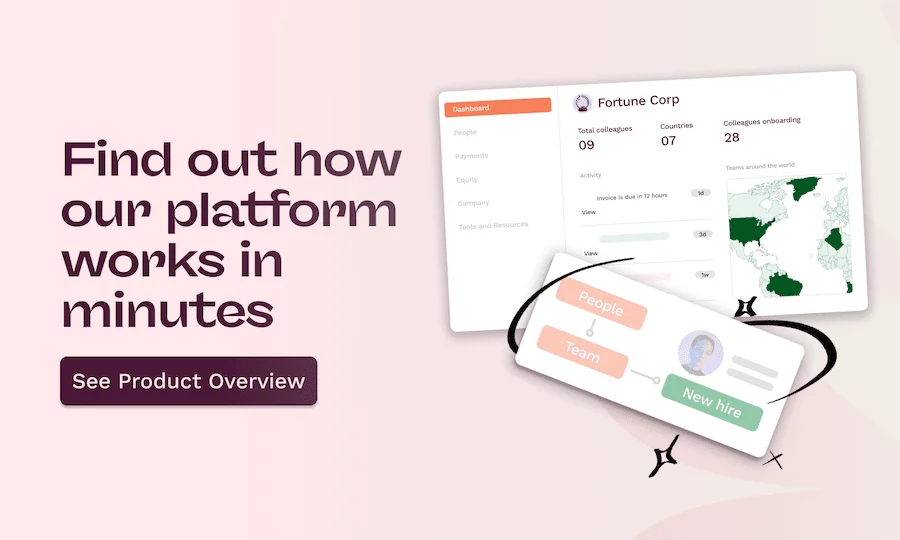What is a common-law employee?

Common-law employee
According to the IRS, a common-law employee is someone who performs work for an organization that has control over what work is done and how it's done—it's essentially a "traditional" employer-employee relationship. The designation applies to both full- and part-time employees.
Determining whether someone is a common-law employee comes down to how much control the employer has over the details of how a given individual performs their work. According to the IRS, you must examine all evidence of the degree of control and independence in the relationship, which falls into three categories: behavioral, financial, and the relationship of the parties.
Interested in Oyster but want more information about how the platform works? This product overview should help.
How the IRS determines if workers are common-law employees
The IRS uses a three-factor test to determine if someone is a common-law employee: behavioral control, financial control, and the type of relationship. This classification matters because it determines your tax responsibilities.
When someone is classified as a common-law employee, you must withhold federal income taxes and Federal Insurance Contributions Act (FICA) taxes for Medicare and Social Security. Independent contractors handle their own tax obligations.
Getting classification wrong can lead to hefty penalties, and studies suggest the problem is widespread—one found that 10 percent to 30 percent of audited firms in certain states had misclassified employees. Intentionally misclassifying employees as contractors to avoid benefits or paperwork is illegal.
So, how do you get it right? The IRS uses a three-part test to evaluate worker relationships:
Behavioral control: Do you control how, when, and where the work gets done?
Financial control: Do you control pay rates, expense reimbursements, and provide tools?
Type of relationship: Do you provide benefits and expect ongoing work?
Some states have also implemented additional tests to differentiate between employer-employee relationships and independent contractors. According to state common-law employee definitions, an individual is an employee if they have to take direction from an employer, their work is within the scope of the company's normal business activities, and the employee doesn't have an independent business that performs the same or similar work.
Depending on the state law, individuals may need to meet some of or all these qualifications to be classified as an employee.
The factors contributing to a common-law employee designation include:
The employer determines the days and hours an individual works
The employer has to approve all the individual's decisions, and the level of oversight depends on the worker's experience and length of service
The employee has to provide regular updates to the employer
Customers or clients belong to the employer, not the worker
The employer pays a set salary or hourly wage
The employer provides medical insurance and other benefits
Tax implications of common-law employee classification
Properly classifying a worker as a common-law employee triggers specific tax responsibilities for you as the employer. Getting this right is key to staying compliant and avoiding financial penalties.
When a worker is a common-law employee, you're required to:
Federal income tax: Withhold taxes from their wages
FICA taxes: Withhold and pay both employee and employer portions for Social Security and Medicare
FUTA tax: Pay federal unemployment tax on their wages. The FUTA tax rate is 6.0% on the first $7,000 paid to each employee during the year.
For independent contractors, these responsibilities don't apply. Contractors handle their own tax obligations, including self-employment taxes. Understanding this distinction is fundamental to managing your payroll and tax compliance correctly.
Consequences of worker misclassification
Mistakes in worker classification can be costly. If the IRS determines you've misclassified a common-law employee as an independent contractor, your business could face significant financial consequences. It's a common challenge for growing companies, with one historic IRS estimate suggesting that 15 percent of employers had misclassified 3.4 million workers, highlighting why it's a problem that needs careful attention.
Potential penalties can include:
Paying back taxes for federal income tax, Social Security, and Medicare that should have been withheld
Interest and fines on the unpaid taxes
Liability for back payments on benefits and overtime pay under labor laws
The good news? With clear guidance and the right processes, you can confidently classify your team and minimize compliance risks from the start.
Common-law employees vs. independent contractors
Here are some examples to help you differentiate between independent contractors and common-law employees.
Identifying an employee
Bill is a graphic designer at a marketing company. Here's what makes him a common-law employee:
Fixed compensation: Earns an annual salary with tax withholding
Company benefits: Receives company-sponsored health insurance
Employer control: Manager assigns projects and sets schedule
Company resources: Uses employer-provided computer and software
Based on the amount of control Bill's employer has over his work, the fact that he works the hours established by his manager using tools and equipment owned by the company, and receives benefits, he is an employee.
Identifying an independent contractor
Bill's friend Nancy works for the same marketing company as a freelance writer. She completes assignments regularly at a set pay rate that she negotiated when she signed a contract to provide services to the company. She works from home on a personal laptop, keeps her own hours, and has the option to decline work if she chooses. She receives payment after she completes her assignments and takes care of paying her own taxes and health insurance.
Nancy is an independent contractor. Although the company provides parameters for her work in the form of assignments, Nancy has total control over when and how she works. She provides a service that no one else in the company has the talent or capacity to perform, and she runs her own business, as evidenced by supplying her own equipment, covering her own business expenses, and managing her own taxes.
Simplify global employment classification with expert guidance
Navigating the nuances of worker classification is challenging enough in one country—let alone across multiple. As your team becomes more distributed, ensuring compliance with local labor laws becomes even more critical. You don't have to manage it alone.
Oyster's global employment platform is built with local expertise to help you classify and engage workers correctly, no matter where they are. We remove the guesswork so you can focus on building your team. Ready to hire talent from anywhere without the compliance headaches? Start hiring globally with confidence.
 FAQs
FAQs
What is the difference between a common law employee and a statutory employee?
Common-law employees are classified based on employer control, while statutory employees are specific occupations (like insurance agents) that the IRS treats as employees for tax purposes only.
What happens if I misclassify a common law employee as an independent contractor?
You'll face IRS penalties including back taxes, interest, and fines, plus potential liability for unpaid benefits and overtime.
Do state laws override federal common law employee rules?
You must follow whichever rules are stricter—state or federal. Many states have tougher tests that make it harder to classify workers as contractors.
About Oyster
Oyster enables hiring anywhere in the world—with reliable, compliant payroll, and great local benefits and perks.

Related Resources

.avif)


.avif)

